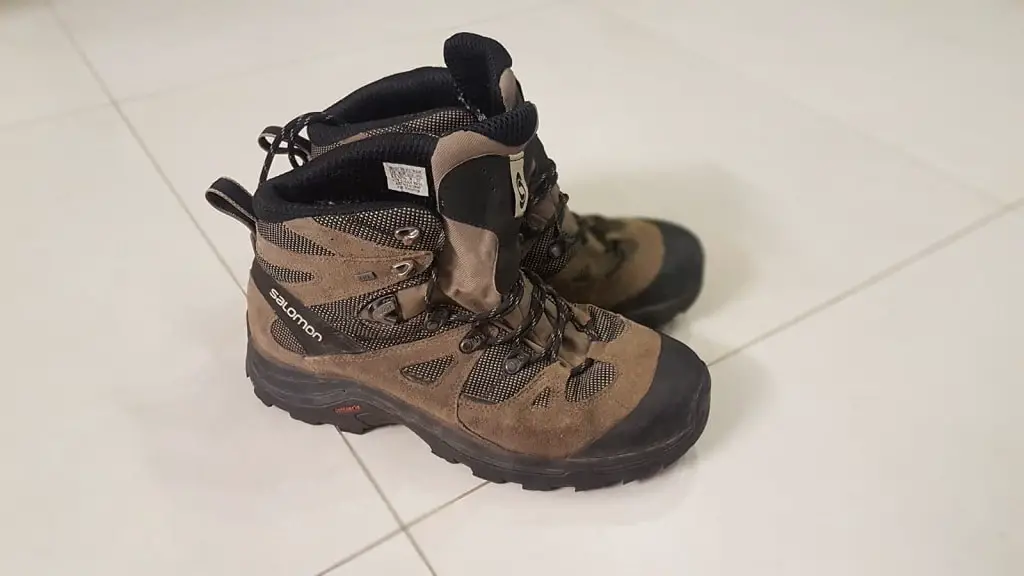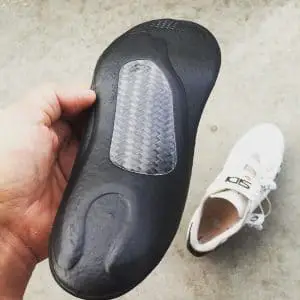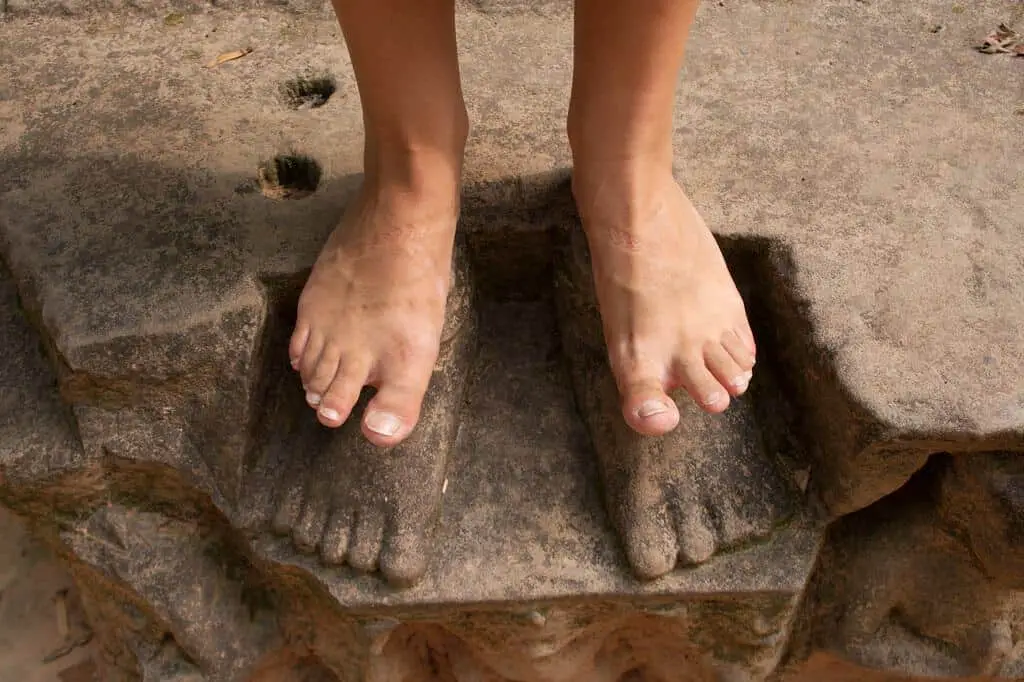Frankly, squeaking boots isn’t something I am personally familiar with. I bought my main boots a long time ago, and they have served me very well over the years. However, I was researching across the internet common problems that might be related to hiking boots and came across the squeaking issue. With less knowledge on that particular subject, I’ve decided to do my little research. A couple of hours reading brought up some results, so let’s dive in and try to figure out why do hiking boots squeak?

The mechanism behind that annoying issue is quite simple.
Hiking boots squeak because of friction forces between two surfaces; which can be anywhere along the boots. It could be between your insole and the boots upper, the outsole and the ground, or even within the boots internal layers.
In this article, I will describe the different scenarios deeply and offer some methods that I’ve found to help you with your problem.
Possible Reasons
The Footbed is Rubbing Against The Seams
Different parts in a boot may cause squeaking, one of them would be its footbed.
That part sometimes may be called the ‘insole,’ is the first layer which touches your foot from the inside.

Many times it is removable so you can choose the one which fits you best. If the insole doesn’t provide well, in some parts, it may lay on the boots seams.
The friction between the two will induce the annoying squeaking sound.
To overcome this and reduce the friction forces between the two, you should apply powder in between, or – get a new insole with a better fit.
The powder method will be described later on under the solutions section.
Your Pair of Boots Just Don’t Fit Well
Another cause can be choosing boots which are too large, hence not fitting well on your feet.
When hiking with boots which are too large, your feet can slide inside freely. This time, the friction is between your foot and the shoe insole.

There are a few ways to overcome this issue. The first will try wearing thick socks which, in turn, ‘fill’ the extra space and prevent sliding.
The other solution would be getting a new pair which is on the right size.
There are different guides over the internet that explain how to find the right fit.
The rule of thumb would be keeping ½ an inch distance between your toes and the boots apex so that you can bend your toes freely – otherwise, it might cause ankle pain.
The Way The Sole is Glued And Fastened to The Upper
If your soles are made of leather – that might be a reason your boots are squeaking. Hiking boots are usually made of the rubber sole, which provides both grips and absorbs shocks.
However, in several cases, it might be made of leather. If your upper is also made of leather, that will end up with two leather layers attached.
When leather materials are rubbed together tightly, it will create a squeaky sound.
You can test this theory by bringing two belt’s ends together and rub them aggressively.
If that is the case, there is not much you can do – it is merely the boots structure.
Your Boots Are Too Slick When You First Buy Them
As opposed to what I’ve just said, leather soles usually should not squeak.
It is more likely for rubber sole to do so, as you might have heard in a basketball game.
That squeak is due to friction between the boots outsole and the surface underneath.
If your boots are brand new, and you feel the squeak is coming from the outside, these are probably good news.
Over time your boot’s sole get roughed up a little, providing a better grip (that would also turn them less slippery).
When this happens, you will notice that your boots tend to squeak less and less as time passes.
Bad Gluing
This one is less under our control, and more due to the boots structure. As you might have guessed, boots are made of several layers glued up together.
The primary layer, which provides most shocks absorber, would be the outsole – this is usually the thickest layer, which also offers grip and traction.
That layer is glued to intermediate layers which differ between different type of boots. The insole, which already described above, is attached to these intermediate layers.
An inappropriate glue attachment can be anywhere along this chain of layers, yet, it would always result with the same annoying thing – squeaking.
How Do You Stop Leather Boots From Squeaking?
Take Your Boots Into a Shoe Repair
No matter where the frictions are coming from, taking your boots to a shoe repair should be one of the first considerations.
They may also take care of the intermediate layers, which are not accessible to everyday users.
What professionals usually do is applying wax or oil on problematic surfaces.
These would decrease squeaking by decreasing friction forces, which can be anywhere along your boots (as described above).
Foot Powder
That solution can be done quickly at home and should be considered if the squeaking comes from friction between your insole and the boots upper.
At first, take off your insole (modern boots usually feature a removable one).
Then, apply a thin layer of talcum powder on the upper, (where the insole used to be) and put the insole back to place.
The main idea behind this is reducing friction – preventing squeaking.
The talcum powder acts as a new layer for your boots, reducing the contact between your insole and the upper part of the boot.
Try Paper Towels & Coconut Oil
Based on the same idea as talcum powder, this can also be done with paper towels or napkins – merely repeat the same process.
However, make sure you apply a thin paper. Choosing a thick one may occupy too much space and would squeeze your feet.
Don’t worry about the paper getting folded or ruptured – it doesn’t have to be perfect. As long it covers most of the insole surface, squeaking should be reduced significantly.
Another approach would be applying a thin layer of coconut oil underneath the insoles. That might sound weird, but people across the internet found it useful.
As we can accomplish with paper towels, oil coconut would decrease the friction so the insole would slide more smoothly on the surface underneath.
Rub The Bottoms of Your Boots With a Dryer Sheet
The idea behind this might be obscure – so allow me to explain. When your boots are wet (the bottom or perhaps – the insole), surfaces which come in touch with it tend to slip on it more easily.
That could be the case with your feet or with the ground underneath. When two surfaces slip with pressure from above, they tend to squeak.
That is why sweaty boots or wet outsole would make more noise than dry ones.
That is where dryer sheet comes into play. Just dry out your in and outsoles, and watch if the squeak got away (or at least improved).
Roughing Up The Bottoms With a Sandpaper
Based on the same principle of wet soles, smooth bottoms would also tend to squeak. That is very typical for new boots, which have not yet achieved their rugged sole.
If that is the case, the squeak would probably decrease over time – although there are means to speed things up.
For that purpose, you may use sandpaper. Merely rough up the boots bottoms until you notice a difference on the outsole surface.
That change would resemble boots which appear a bit older and worn out.
Don’t worry about ‘ruining’ your new pair; they would get the same condition anyway.
How Can I Know Where The Squeak is Coming From?
In most cases, it is challenging to tell where the squeak is coming from.
In my opinion, the best way to figure that out is by elimination. Just follow the steps above gradually and notice whether or not the squeak disappears.
In my opinion, it would be wise to start with the talcum powder, because this one is reversible.
If the squeak continues, try roughing up the outsole with sandpaper and watch what happens.
Eventually, if nothing had worked – the problem is probably with the boots intermediate layers. Then, I think, it would be wise to check up a shoe repair shop.
What Boots Are Known For Being Squeaky?
Boots which are made mainly with leather, especially a full grain one, would tend to be squeaky.
That squeak is more likely to come from the inner layers of the boot, preferably from the outsole — most of the times that would be due to inappropriate gluing of these layers.
An excellent example of squeaking boots would be the Berghaus walking boots.
These are an excellent example for full grain leather boots which would probably squeak due to their design.
When you are choosing your new boots, especially if leather is a significant component in them, make sure to test them upfront at the shop before buying.
If you are ordering online, at least test similar boots at your closest shop. That would lower the chances you will get disappointed.
Should I Return Them or Give Another Chance?
I don’t think throwing away should be your first step.
Hiking boots are expensive and are worth fighting for. In my opinion, you should first try fixing the problem with the problematic pair.
Once you get rid of it, there is no going back – and you have nothing to lose by trying to fix it. Start with some standard approaches, such as the talcum powder or the sandpaper.
After all, these have failed, probably getting a new pair would be the right choice.
Does it Depend On The Surface?
Absolutely yes. Many times the squeaking noise comes from the outer part – friction between your outsole and the ground surface.
For that reason, I advised you to use sandpaper – to rough up the outsole.
As mentioned above, the best example for that would be a basketball player. You are probably familiar with the squeaks the player’s shoes create.
That would happen if your boots feature a rubber outsole and the ground underneath is wet rocks.
Test your boots on a dry surface – if the squeak disappeared, that would probably be the reason.
What Steps Should I Do First With Brand New Boots?
If your boots are brand new, you should probably try consulting the store workers, perhaps even return them.
That is of course if the problem is with the specific pair you’ve bought. Some boots feature glue issues which might be solved with a different couple.
If you are not able to return these, you should try some of the steps mentioned above.
An excellent way to start would be using the talcum powder since it many times solves the problem, and it is a reversible method.
Besides, you should also consider that the squeak is due to the boots being new.
As mentioned above, this problem would gradually resolve, as the outsole would get more and more worn out.
Conclusions
Squeaking is an annoying issue; however, there are ways to overcome this.
It happens due to friction between the different parts of your boots – like the outsole, intermediate layers or the insole itself.
Sometimes it may be due to an inappropriate gluing or a bad fit when sometimes it would be just the way a brand new pair behaves.
There are several ways to approach this issue when all of them are based on decreasing friction between the two problematic layers.
You may start with talcum powder (if the problem is between your insole the boots upper), or try rough it up with sandpaper (if the outsole is the issue).
A brand new pair may squeak because its outsole is not rough enough – to give it some time.
If the issue is terrible, and nothing else worked, you may try to return the pair or buy a new one.

